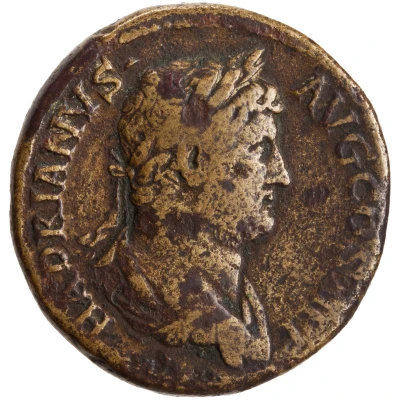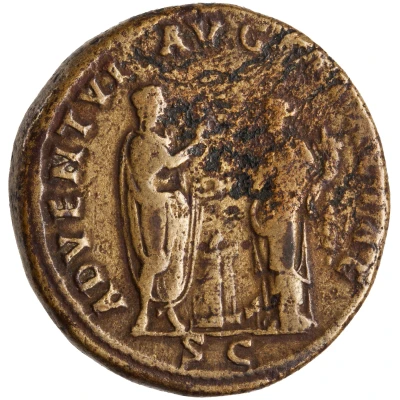


© American Numismatic Society (ANS)
Sestertius - Hadrian ADVENTVI AVG ITALIAE S C; Italia
| Orichalcum | 25 g | 32.5 mm |
| Issuer | Rome › Roman Empire (27 BC - 395 AD) |
|---|---|
| Emperor | Hadrian (Publius Aelius Hadrianus) (117-138) |
| Type | Standard circulation coin |
| Years | 130-133 |
| Value | 1 Sestertius = ¼ Denarius |
| Currency | Denarius, Reform of Augustus (27 BC – AD 215) |
| Composition | Orichalcum |
| Weight | 25 g |
| Diameter | 32.5 mm |
| Shape | Round (irregular) |
| Technique | Hammered |
| Demonetized | Yes |
| Updated | 2024-10-06 |
| Numista | N#256243 |
|---|---|
| Rarity index | 100% |
Reverse
Hadrian standing right, raising hand and holding scroll; facing him, Italia standing left, holding patera and cornucopia; between them, altar, usually with bull at the base.
Script: Latin
Lettering:
ADVENTVI AVG ITALIAE
S C
Translation:
Adventui Augusti Italiae. Senatus Consultum.
Adventus (Roman welcoming ceremony) of the emperor (Augustus) to Italy. Decree of the senate.
Comment
Source: Online Coins of the Roman Empire (OCRE)Interesting fact
The Sestertius coin , which features Emperor Hadrian and the inscription "ADVENTVI AVG ITALIAE S C," is notable for its use of the metal Orichalcum. Orichalcum was a type of brass alloy that was used in the production of some Roman coins during the 2nd century AD. It was prized for its durability and resistance to corrosion, and was often used to produce coins that were meant to be used for a long time or to be stored as treasure. The use of Orichalcum in this coin suggests that it was intended to be a high-quality, long-lasting coin that would be used for important transactions or as a symbol of the Roman Empire's wealth and power.